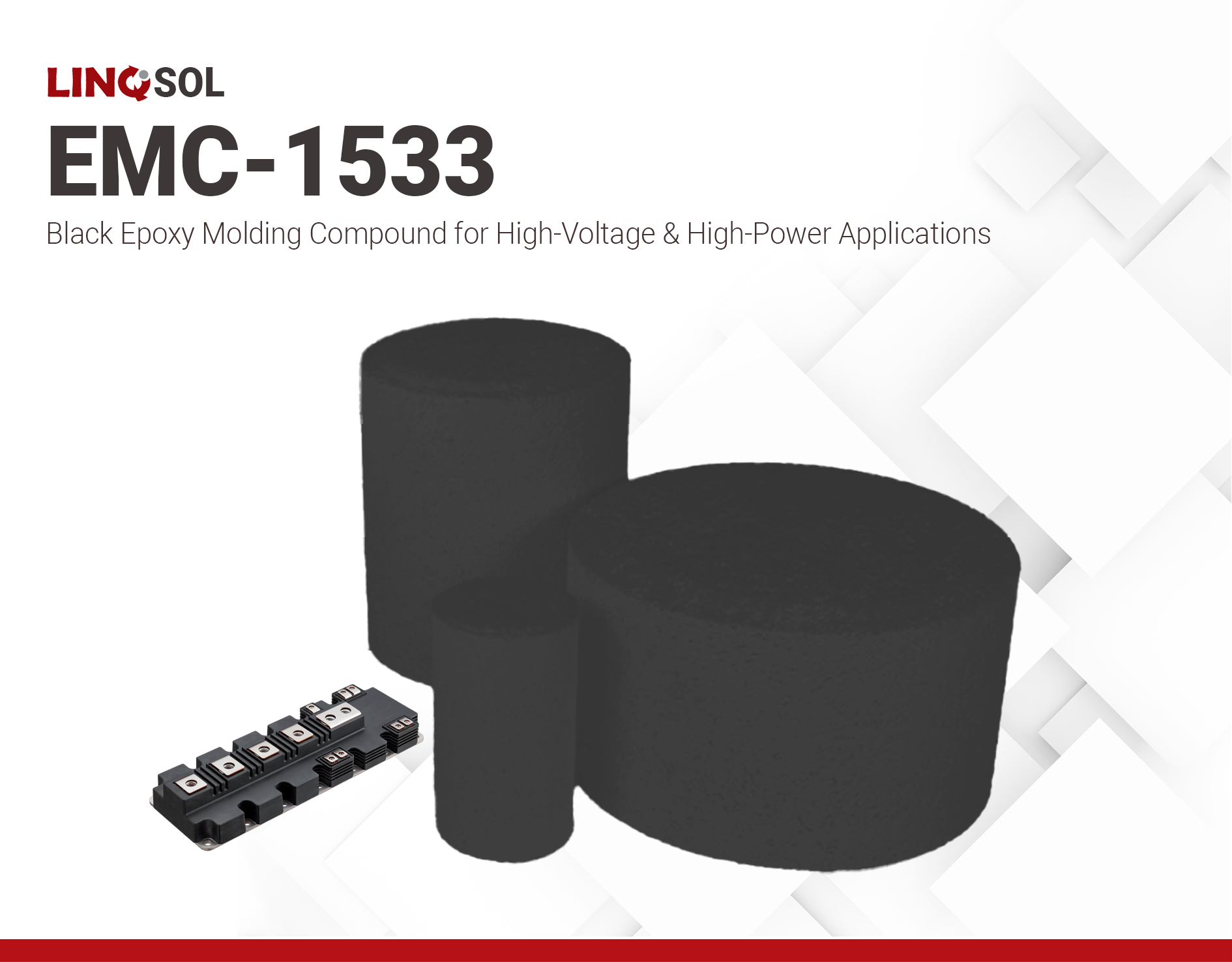LINQSOL EMC-1533 | Black Epoxy Molding Compound
- Green molding compound
- Designed for transistor outline (TO) and double decawatt (D2PAK) packages
- Excellent workability, low water absorption, low modulus, and excellent thermal stability
Product Description
LINQSOL™ EMC-1533 is a halogen-free epoxy molding compound tailored for transistor Outline (TO) and D²PAK devices. Its low modulus minimizes package stress while maintaining a high glass-transition temperature of 170 °C for thermal stability. Its excellent flow characteristics enable smooth transfer molding. The compound also meets UL 94 V-0 flammability, ensuring robust safety margins. EMC-1533 boasts of its cost effectiveness and excellent workability with more than 500 continuous mold shots.
LINQSOL™ EMC-1533 guarantees strong performance and outstanding long-term reliability in demanding environments. This product is deliberately formulated without the inclusion of substances prohibited by the European Union RoHS and REACH. Overall, LINQSOL™ EMC-1533 seamlessly integrates advanced material properties, safety compliance, and superior performance to deliver a reliable solution for semiconductor device encapsulation.
LINQSOL™ EMC-1533 is available in pressed pellets in a wide range of sizes to meet specific customer needs. Contact us for more product information, custom sizes, or other specific requirements.
Key Features
- Low Modulus, Low Stress: Reduces package warpage and wire-bond strain during thermal cycling.
- High Tg 170 °C: Maintains mechanical strength at elevated junction temperatures.
- Excellent Flowability: Fast 20 s gel time @ 175 °C supports high-yield transfer molding.
- UL 94 V-0 Flame Rating: Ensures self-extinguishing behavior for consumer and industrial safety.
- Halogen-Free & RoHS/REACH-Compliant: Avoids regulated substances for global market acceptance.
- Proven Reliability: Passes 500 h HTRB, 98 h PCT and 500 thermal cycles for long-term durability.
Designed for
- TO-220 (single & multi-lead power transistors, IGBTs)
- TO-252 / DPAK (surface-mount MOSFETs, regulators)
- TO-263 / D²PAK (high-current MOSFETs, Schottky diodes)
- TO-247 (high-voltage discrete devices, rectifiers)
Reliability Tests Passed
- HTRB, Tₐ=125°C, V=80%VR * 500 hour
- PCT, Tₐ=121°C, P=0.215atm, RH=100%* 98 hours
- Thermal Cycling Test, -55°C - +150°C * 500 cycles
LINQSOL™ EMC-1533 closely matches Hysol GR300, which shares a 170 °C Tg, 125 MPa flexural strength, and similar flow/gel characteristics, making it a practical drop-in alternative.
Technical Specifications
| General Properties | |||||||
| Filler Content | 80 % | ||||||
| Filler Size Cut | 75 µm | ||||||
| Specific Gravity Specific Gravity Specific gravity (SG) is the ratio of the density of a substance to the density of a reference substance; equivalently, it is the ratio of the mass of a substance to the mass of a reference substance for the same given volume. For liquids, the reference substance is almost always water (1), while for gases, it is air (1.18) at room temperature. Specific gravity is unitless. | 1.9 | ||||||
| Physical Properties | |||||||
| Spiral Flow @ 175°C | 68 cm | ||||||
| Chemical Properties | |||||||
| |||||||
| Moisture absorption | 0.4 % | ||||||
| Electrical Properties | |||||||
| |||||||
| Volume Resistivity Volume Resistivity Volume resistivity, also called volume resistance, bulk resistance or bulk resistivity is a thickness dependent measurement of the resistivity of a material perpendicular to the plane of the surface. | 7.5x1016 Ohms⋅cm | ||||||
| Mechanical Properties | |||||||
| |||||||
| |||||||
| Molded Shrinkage | 0.33 % | ||||||
| |||||||
| Thermal Properties | |||||||
| |||||||
| |||||||
| Glass Transition Temperature (Tg) Glass Transition Temperature (Tg) The glass transition temperature for organic adhesives is a temperature region where the polymers change from glassy and brittle to soft and rubbery. Increasing the temperature further continues the softening process as the viscosity drops too. Temperatures between the glass transition temperature and below the decomposition point of the adhesive are the best region for bonding. The glass-transition temperature Tg of a material characterizes the range of temperatures over which this glass transition occurs. | 170 °C | ||||||
| UL 94 Rating UL 94 Rating Flammability rating classification. It determines how fast a material burns or extinguishes once it is ignited. HB: slow burning on a horizontal specimen; burning rate less than 76 mm/min for thickness less than 3 mm or burning stops before 100 mm V-2: burning stops within 30 seconds on a vertical specimen; drips of flaming particles are allowed. V-1: burning stops within 30 seconds on a vertical specimen; drips of particles allowed as long as they are not inflamed. V-0: burning stops within 10 seconds on a vertical specimen; drips of particles allowed as long as they are not inflamed. 5VB: burning stops within 60 seconds on a vertical specimen; no drips allowed; plaque specimens may develop a hole. 5VA: burning stops within 60 seconds on a vertical specimen; no drips allowed; plaque specimens may not develop a hole | V-0 | ||||||
Additional Information
Recommended Mold Parameters
| Parameter | Value | Unit |
|---|---|---|
| Molding temperature | 170–190 | °C |
| Transfer pressure | 40–90 | kg/cm³ |
| Transfer time | 10–25 | sec |
| Cure time at 175 °C | 1.5–2 | min |
| Post mold cure time at 175 °C | 6-12 | h |
| Post mold cure time at 190 °C | 4-6 | h |
To achieve the best results, test the recommended conditions on the mold. Users should conduct their own testing to ensure it meets their specific needs and application.
Processing Instructions
- Before use, let LINQSOL EMC-1533 reach room temperature for 24 hours. Keep the bag unopened and stored in a dry location with a relative humidity of ≤50% during thawing to prevent moisture contamination.
- Use the materials within 72 hours after removing the container from cold storage.
Storage and Handling
LINQSOL EMC-1533 is available in pressed pellets in a wide range of sizes to meet specific customer needs. To ensure product integrity, keep it away from oxidizing materials. For long-term storage, maintain a cold environment. The shelf life at 5 °C is 183 days.



